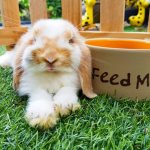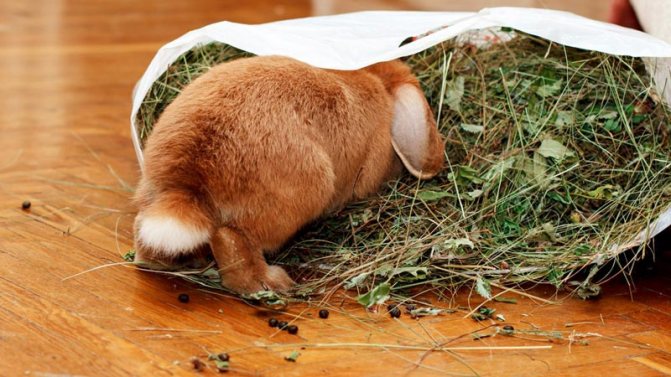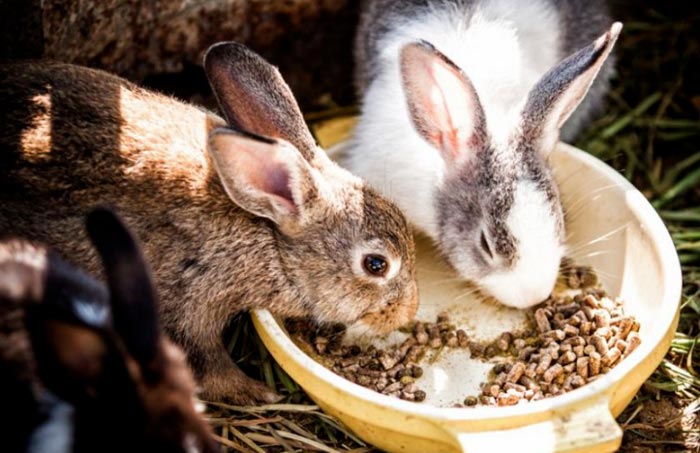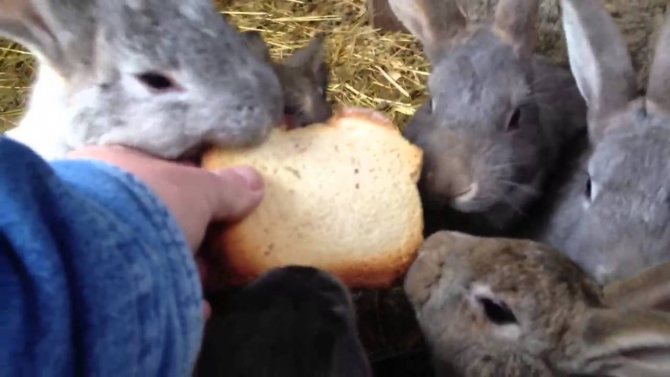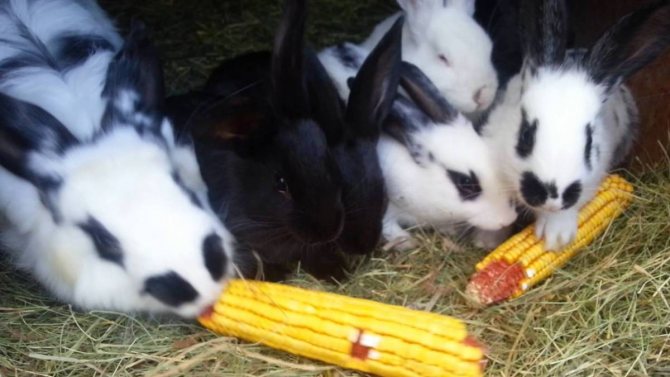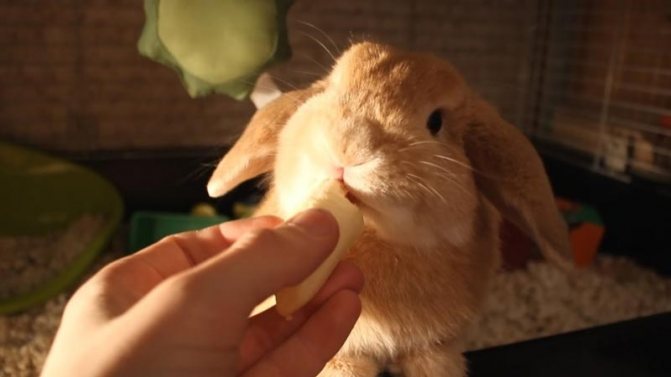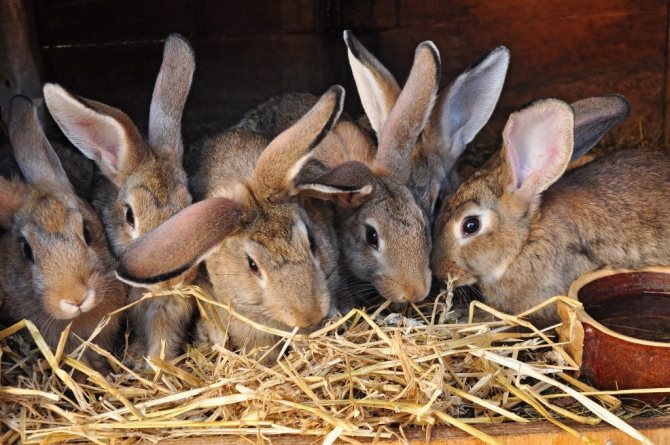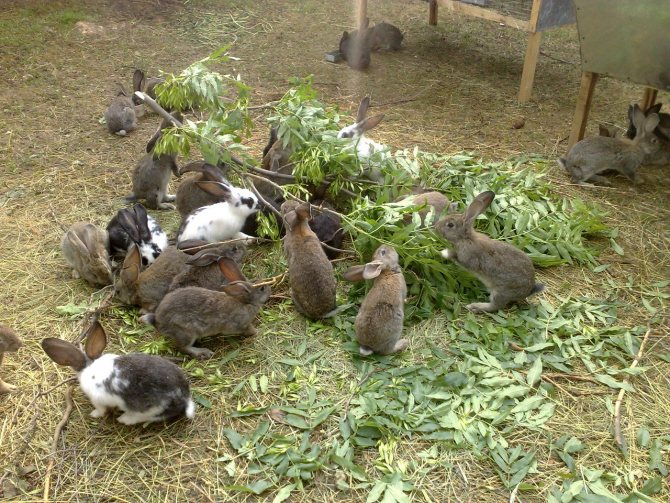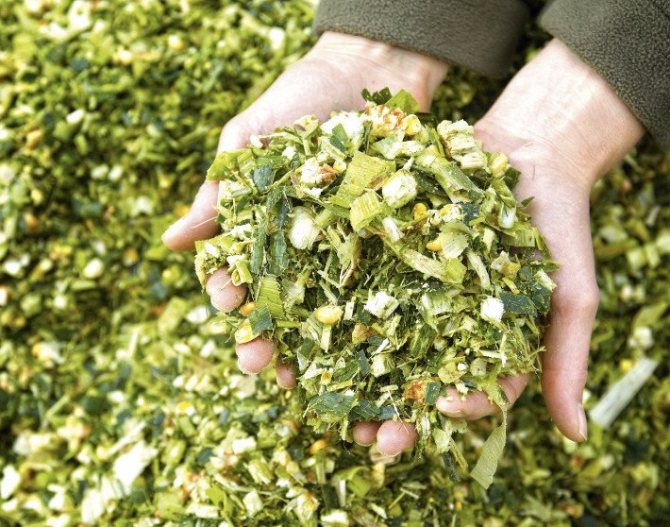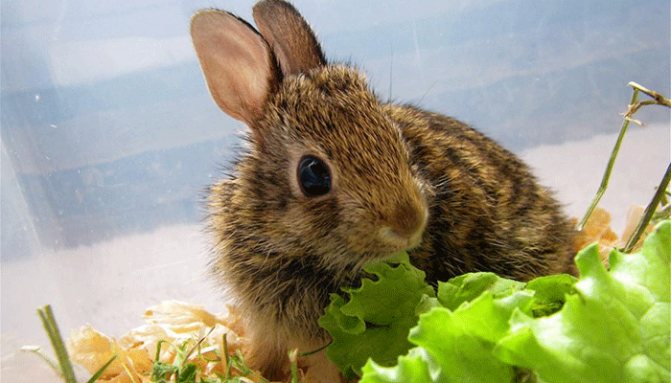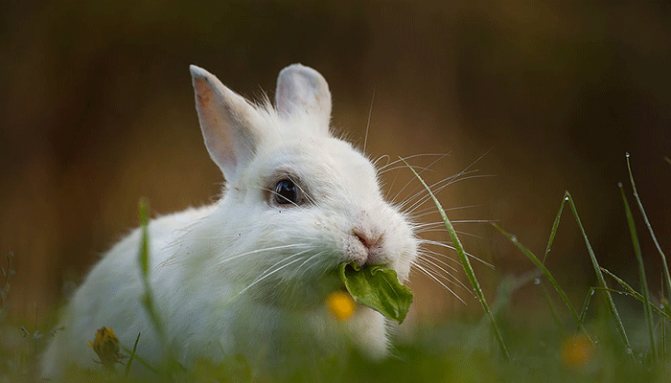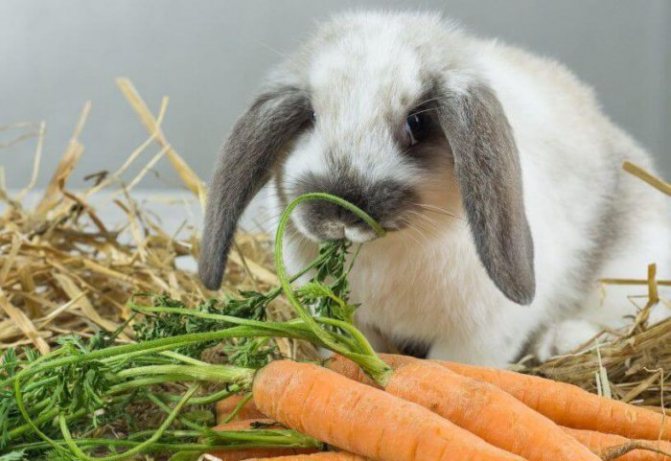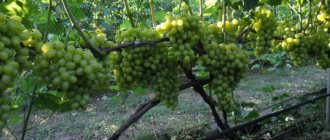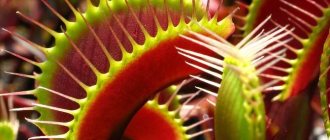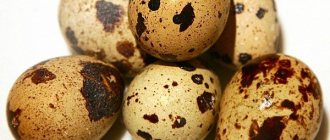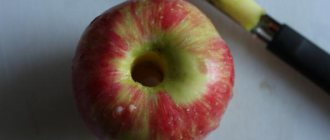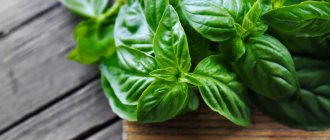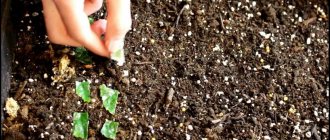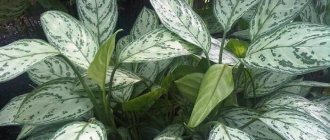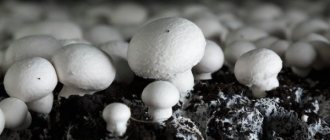»Livestock» Rabbits »What is the best way to feed rabbits
0
476
Article rating
Novice farmers often ask the question of how to feed rabbits. The diet of animals must be balanced. Foods of different types are given in certain proportions: the winter and summer menus differ from each other, it has its own characteristics in different periods of the pet's life.
What is the best way to feed rabbits
What to feed rabbits
Rabbits are vegetarians and their diet consists of plant foods. In the wild, the animal is free in the choice of food and intuitively chooses those plants that are useful and necessary for the body at the moment.
In captivity, the care of the nutritional value falls on the shoulders of the livestock owner. Farmers use ready-made feeds for their pets, which include the elements necessary for the animal. At home, not all novice rabbit breeders can afford to feed rabbits with ready-made mixtures. The compound feed can be replaced with grass, hay, grain and vegetables.
Green feed
Grass, leaves, young shoots of trees are excellent food for the animal in the warm season. In the household, in the summer, rabbits are fed with cut grass, giving preference to the following crops:
- legumes - clover, sainfoin, alfalfa;
- meadow - bonfire, hedgehog, foxtail, chamomile, tansy, yarrow, timothy, plantain, dandelion;
- tops of some garden plants (beans, peas, Jerusalem artichoke, corn, carrots, fodder beets, garlic).
The animals happily eat strawberry, oak, rowan, apple, parsley, mint and dill leaves.
All herbs are slightly dried in the shade before feeding to pets. Giving greens juicy and wet with dew to rodents is dangerous - digestion can be upset.
You can feed rabbits with tender shoots of trees and shrubs - apple, pear, currant, oak, mountain ash, willow, hazel.
Juicy feed
Juicy foods include fruits and vegetables. You can feed the rabbit at home with the following products: carrots, pumpkin, zucchini, fodder beets. Beets are given a little, as they have a laxative effect. The root vegetable is useful as a lactating food for lactating females.
Animals destined for meat are given boiled potatoes during the fattening period.
Vegetables can be fed raw, whole or sliced. You should clean them of dirt, cut off damaged and rotten parts.
Rabbits love apples, pears, melons and watermelons.... Apples are an affordable and cheap product; they can not only be given fresh, but also dried for the winter to provide the animals with vitamins.
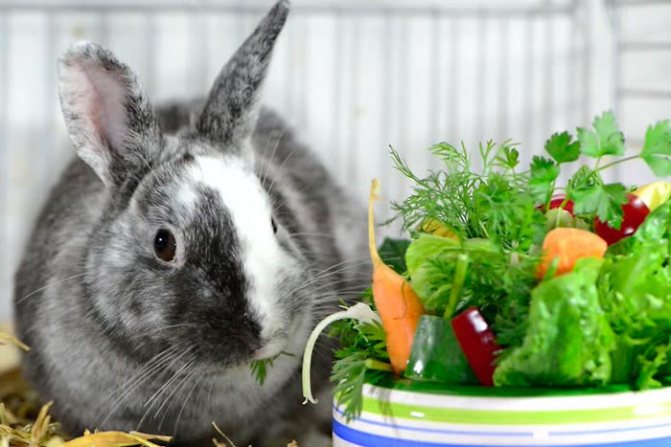
Roughage
Hay and straw are used to feed livestock in winter. Hay is harvested from those grasses that are used as food for animals in summer. Leguminous and cereal hay (fire, young oats, Sudanese grass) is considered nutritious. Forest plants are not as satisfying, but they are richer in the content of useful herbs and tastier for the animal.
Rabbits eat at home and straw, giving preference to oatmeal and barley. The straw nutritional value is low. Experienced farmers increase its energy value by grinding the product and steaming it with boiling water. The softened straw cut is sprinkled with bran and fed to the animals.
Concentrated feed
Concentrates are called grains, bran, oilcakes. - foods containing a high percentage of protein, protein and fat.Their share in the rabbit's menu reaches 40%.
On farms, livestock are fed with special mixtures - compound feed... The recipe is developed separately for each group of animals: young animals, pregnant and lactating rabbits, adult males.
At home, rabbits eat cereal mixtures, which were made by the breeder. To feed the animals, whole or crushed grains of oats, barley, corn, peas (they give only ground!), Wheat, triticale are used. Wheat bran, rich in B vitamins, constitutes about 15% of the mixture.
Oil cake or sunflower meal is a fatty and healthy food for a rabbit. The cake is fed at 10-30 g per day per individual.
Diet formulation and feeding regimen
Breeding chickens at home for beginners
When compiling a diet, it is important to take into account the age, breed and health of the animal. It is convenient to calculate the feeding rate of rabbits in feed units, for example, taking one unit for 1 g of oats. So, a list of norms in the number of units for medium-sized rabbits:
- animals not intended for breeding - 110-170;
- in preparation for mating - 170-210;
- pregnant female - 200-240;
- lactating female in the first 2 weeks after birth - 260-320;
- lactating female with one month old rabbits - 430-500;
- lactating female after a month after birth - 550-700;
- rabbits up to 3 months - 100-150.
On average, the amount of roughage should be 50-60% of the total rabbit feed, 40% is allocated for juicy and green feed. At the same time, it is important to understand that for rabbits of decorative breeds (Dutch, Braband), a smaller amount of food will be enough than for their larger counterparts.
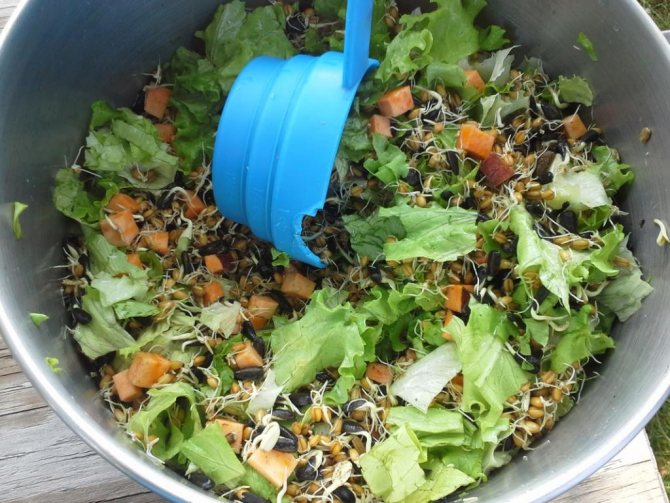

Juicy feed
If rabbits are kept for meat, then they should be given more high-calorie foods, such as oats, wheat, mixed feed, and exclude hay and fresh grass from their diet. For overweight animals, you can replace part of the feed for hay or succulent feed, but in no case just reduce its amount. For long-haired rabbits, it is sometimes necessary to add flaxseed to the feed, as it has a beneficial effect on the quality of the wool.
In addition to food, there must be fresh water in the cage. It is necessary to make sure that no droppings, hay or feed residues get into the drinker and change the water in time. If possible, it is better to make a drinker for rabbits in a drip form. Firstly, this will prevent food from entering and spoiling water, and secondly, animals will not be able to turn it over.
Note! It is better to use boiled or distilled water, never from the tap. Such water often contains a large number of various impurities, including chlorine, which have a negative effect on the teeth of rabbits. If there are sick or weakened animals in the cage, then an additional source of water should be placed next to them.
Use of vitamin and mineral supplements in feeding
If the menu is made up of simple and natural products (grains, herbs, vegetables), you cannot do without additional giving of vitamins and minerals. As a mineral supplement for strong bones and teeth you can give the rabbits chalkby adding it directly to the grain mixture. Instead, they use pieces of limestone that are simply placed in a cage. As a source of minerals, the animal is also offered:
- pieces of charcoal;
- clay or expanded clay;
- turf carved in the field.
An obligatory component of the daily menu is table salt. The daily norm is 3-5 g per animal. Excessive salt can poison your pet.
In winter it is useful to give the animals complex vitamins... Water-soluble formulations are used (Chiktonik, Tetrahydrovit), which are added to drinking water. The course of drinking with vitamins is 3–6 days, monthly.
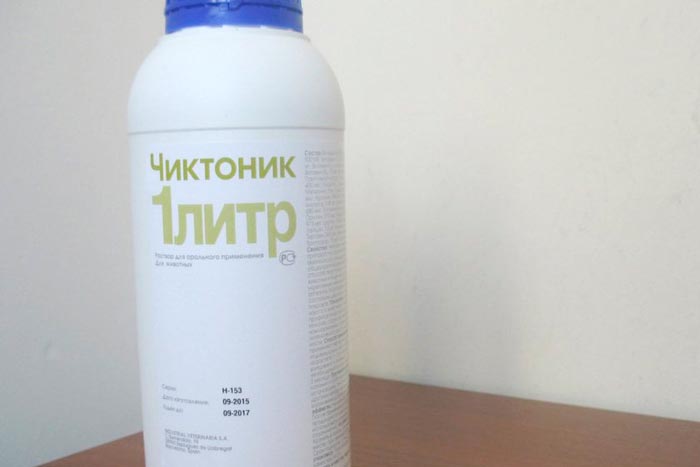

Chictonik


Tetrahydrovit
General nutritional information
Small domestic rabbits, although they belong to the lagomorph family, to some extent lead the way of life of rodents.
Such animals need to regularly grind their teeth, because eared pets often try to chew on any hard objects in the house: furniture, baseboards, shoes, TV and computer cords.
The vital diet of fluffies is plant food that is not high in calories and nutritious, so they can eat all day long and in impressive portions, which is very unhealthy.
The best feeding option is 2-3 times a day. In this case, you need to ensure that the pet always has clean drinking water in the cage.
What to feed
Brewer's yeast, iodized salt, mineral stones and chalk contribute to the normal digestion of the ornamental rabbit. These vitamin and mineral supplements are available at pet stores.
How to feed rabbits properly
Livestock are fed 1-2 times a day, when using bunker feeders, you can set a portion of food for 2-3 days. It is recommended to give concentrates dry, and not in the form of porridge. This prevents rabbits from getting their faces dirty and food does not spoil in the heat. It is allowed to spray the crushed with water so that it does not become dusty.
The diet of rabbits should include all groups of feed: coarse, juicy, concentrated, vitamins and minerals... It is allowed to reduce the amount of concentrates, vegetables and fruits for animals at rest.
For a domestic rabbit, a menu with a minimum proportion of grain is selected to avoid obesity.
Summer diet
In the summer, it is rational to use cheap food to the maximum - grass and branches. To feed the rabbits properly, you need to prepare the greens first. It is dried to avoid bloating. An adult rabbit is given up to 1 kg of greens per day.
An example of a summer animal menu:
- adult animals during the dormant period - 500-800 g of grass, 40-60 g of grain mixture;
- pregnant females - 800 g of grass, 80 g of concentrates;
- lactating females - 1200 g of grass, 100–150 g of grain;
- young animals after weaning - 300 g of grass, 30–50 g of grain.
The animals need to be given chalk and salt, 3-5 g of each individual.
Feeding rabbits in winter
The food of animals in winter should be varied and more nutritious; the menu includes vegetables. An example of a daily diet:
- for animals at rest - 200-300 g of hay, 70-80 g of concentrates, 150 g of juicy feed;
- for nursing and lactating rabbits an increase in the norm of vegetables and fruits (dried fruits) up to 500 g, and grain mixtures - up to 200 g is provided;
- young give about 100 g of hay, 80-100 g of grain, vegetables can be fed to rabbits in an amount of 50-80 g.
All rabbits require vitamins: liquid solutions are dripped into drinking water or a dry premix (Ushastik) is added to the grain mixture.
Why the right diet is so important for rabbits
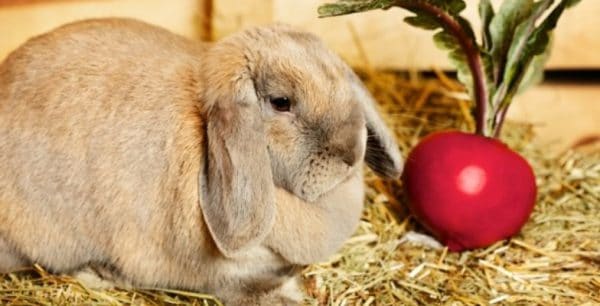

A balanced diet allows you to achieve a quick increase in live weight at the lowest cost of feed and money.
A well-fed and healthy rabbit carries and feeds more than 30 young rabbits in a year. With optimal nutrition, the slaughter weight of young animals of 3.5–4.5 kg is achieved in 120–150 days.
Proper nutrition will cover the females 3-5 days after the birth of the rabbits.
How to feed decorative rabbits
Dwarf and decorative breeds need approximately the same nutrition as farm animals. Many rabbit owners choose to feed their pets. ready-mix, including the required minimum of nutrients. Popular brands: Vitakraft Menu Vitel, Benelux Funny, Fiory Karote. Do not limit yourself to store-bought feed mixtures: the animals will be happy to eat juicy food and dried grass... Their share in the diet should be at least 20%.
We must not forget that, in addition to food, rabbits need to grind their teeth. To do this, they are given twigs, special grain sticks.You cannot overfeed pets with grain. Bunny rabbits are prone to obesity if they eat foods high in carbohydrates.
Juicy feed.
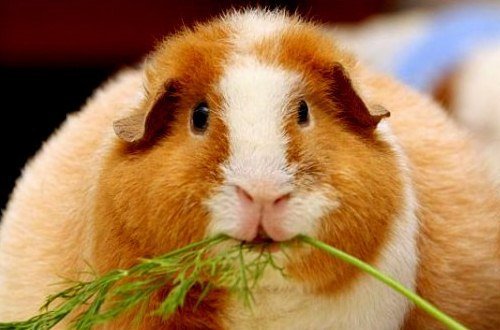

An adult male eats dill.
If the "rabbit" knew how to talk, he said that he prefers grass for dinner. Juicy food is a favorite treat for every furry animal. Therefore, it is worth feeding the animal with juicy food.
The herb is able to prevent some diseases and cure the rabbit. Domestic animals often do not distinguish which one is useful.
Over the centuries of life with a man, the rabbit has lost the ability to choose the juicy food he needs and therefore is able to gorge himself on hawthorn, nettle. These herbs cause intestinal upset, up to the onset of bleeding.
Dandelion, plantain, coltsfoot leaves, nettles and other herbs are useful for a small rodent.
Rules and features on the video:
The main rules for collecting grass:
- Do not tear, but cut or mow. With this method, the sap of the plant will be preserved, the harmful root system will not enter the food.
- Avoid mowing along busy roads. Exhaust gases deposited on the ground and grass will not benefit your pet.
- Do not collect after rain or dew. It will deteriorate quickly.
- Where dogs are walked, do not choose a gathering place. It is possible to understand that each individual individual prefers more of the succulent herbs only by experience.
Compound feed
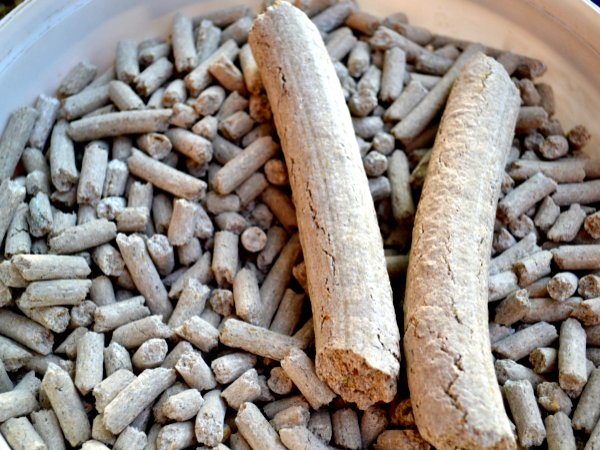

This is what pellets look like
A simple option to provide adults with complete food is to use pelleted feed. The latter are made in factories, focused on individual rabbits, so buying just some kind of compound feed means feeding them food for pigs.
Granulated feed for adults contains:
- Not less than 30 percent of herbal flour from the total composition. Made from any vegetation where vitamins have been added. Herb flour is obtained using alfalfa and clover base;
- Oats or wheat 20%. The use of forage grain varieties is quite justified. The grain should not be treated with pesticides from rodents;
- Corn or barley 20%. In factories, add in equal parts.
- 15% wheat bran, or any other. Manufacturers believe that the main thing is that the bran is dry, otherwise the finished product will quickly deteriorate.
- Sunflower cake in the amount of 13%. An important component that is responsible for the rabbit's fur, it reduces the likelihood of getting it into the stomach;
- Fish or meat meal, bone meal, yeast and table salt. These components are allocated 4 percent.
Cooking - Norms: Finishing young animals must consume a different feed composition. So grass flour 40%, barley - 30, but sunflower meal 10.
The use of compound feed in the daily diet leads to weight gain. On average, 30 - 35 grams per day.
Replacement of natural food with compound feeds leads to the fact that the animal will be provided with the necessary set of vitamins and microelements.
Vitamin and mineral supplements in winter and summer
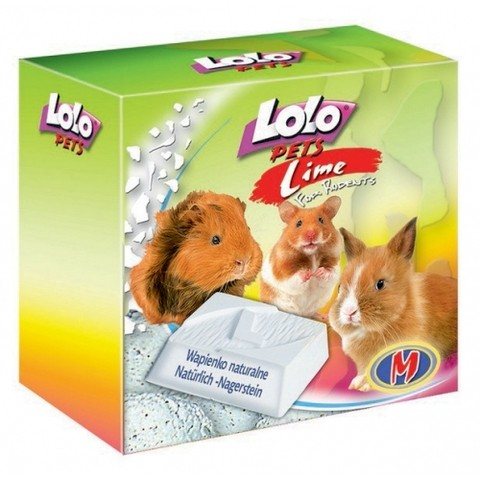

Vitamins are sold in boxes - an approximate cost of 50 rubles for 60g.
It is not worth giving vitamins separately, then when there is an uninterrupted supply of fresh grass or there is compound feed in the diet. Excessive vitamins are dangerous for growth.
At the end of winter, early spring, when the quality of hay for natural reasons deteriorates, and compound feed is not used in the diet, you need to enrich your usual food with special mineral additives.
To summarize, a healthy individual is obliged to receive vitamins daily:
- A. Responsible for growth, the state of the nervous system, as well as reproductive functions;
- D. Its absence leads to rickets and a high degree of bone fragility;
- E is necessary for normal reproduction and muscle elasticity;
- B12 is at least responsible for the normal functioning of the rabbit liver;
- Folic acid and biotin. They are extremely important for the health of the skin and coat strength.


Table: "How to feed properly." Using this table will eliminate the question of how to feed a decorative and dwarf individual
It is impossible to consume vitamins by dropping their solutions "by eye". The dose is determined by the veterinarian. An experienced veterinarian will tell you which manufacturers are preparing vitamin and mineral supplements.
Mineral additives are important for vitality, the main one is chalk. Add to prepared food (except for granulated feed). The percentage of crushed chalk - minimum - 0.5%, maximum - 1% of the total amount of each feed.
Professional advice
Add table salt and bone meal to your food. In parts from 0.5 to 1 (in the case of salt - 2) percent. Ornamental breed eats: cookies, cornflakes, other human food. But it is categorically impossible to feed him with these products. Obesity and cirrhosis of the liver will be provided to him.
The average life expectancy of a decorative species is 8 years. The presence of vitamins in the daily diet increases their lifespan up to 10 years.
The rabbit will not get sick, it will reproduce healthy offspring, without giving the owner additional trouble.
What is needed for rapid growth and weight gain
For rapid muscle growth, you need energy, protein and vitamins. Most of these substances are found in such plant products:
- bean hay;
- grain of corn, barley, peas, wheat;
- sunflower cake.
Vitamins are required to assimilate nutrients. The record holder for the content of nutrients necessary for a rabbit is carrots.
Small home farms successfully use boiled potatoes mixed with wheat bran for the final stage of feeding rabbits for meat.
Rapid growth of animals
Active growth of young animals provides fortified feed. The diet of rabbits includes leguminous hay, mown in the budding and flowering phase, carrots, apples, a mixture of barley, corn and wheat. Buckwheat is considered a useful cereal that strengthens the body. It is given dry as part of grain mixtures.
Fast weight gain
Fattening rabbits should be given up to 40% of the concentrates from the daily diet. Instead of crushed grain, you can feed the animals with cereals - they are more fully digested. Nutritious cereals: corn, pearl barley, peas, yach, wheat.
Vegetables can be eliminated by replacing them with potatoes, acorns, cake.
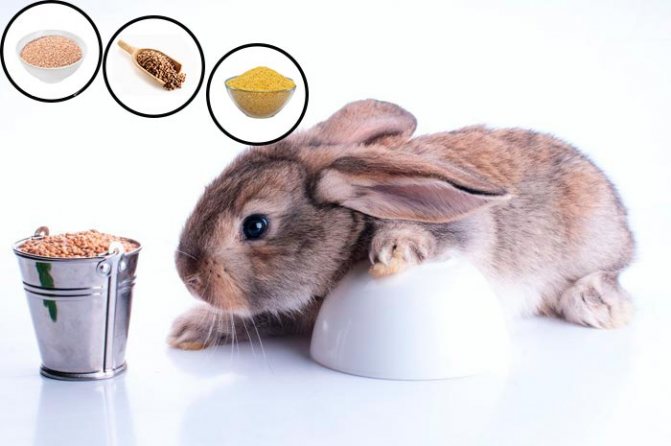

The difference between factory feed and natural
Every livestock breeder should know what to feed a decorative rabbit. In stores, the consumer is offered a large selection of various feeds. They are rich in vitamins, minerals, acids. But if you feed the animals exclusively with commercial food, then they will begin to gain weight quickly. Therefore, it is often forbidden to give this type of feed. With daily use of dry food, the pet will begin to refuse natural food. And this type of food must be present in the diet. Therefore, commercially available feed should be given in limited quantities. Experienced breeders recommend giving them to animals as a reward or treat. It should be noted that the eared ears are herbivores. Mixtures of dry fruits, grains, nuts are undesirable for them. Correctly selected quality feed contains 20% unrefined fiber, 1% calcium and fat, 15% protein.
What you shouldn't feed rabbits
The list of foods prohibited from feeding to rabbits is long. Animals have a delicate stomach and a tendency to produce gas. Bloating and diarrhea are often fatal, especially in young animals.
Poisonous plants and herbs
Among the herbs that should not be given to animals are: celandine, buttercup, lumbago (and all primroses), hellebore, hemlock, foxglove, wrestler, cicuta, wild mustard, dope, sweet clover, St. John's wort.These include branches of cherry, poplar, birch.
The breeder needs to know what poisonous plants look like and choose them from the cut grass. If one twig does get into the trough in the hay, the well-fed animal will not eat the dangerous product.
Cabbage stumps
Contrary to popular belief, rabbits are not fed cabbage. It causes active gas and diarrhea. The cabbage stumps contain an increased amount of nitrates.
Rabbits can be fed 1 green kale coverts per day.
Potatoes
The animals are fed only boiled potatoes. Sprouted and green tubers should not be given, they have accumulated poison - solanine.
Sunflower seeds
Whole or crushed seeds are not given by animals because of the hard-to-digest shells. The peel from the seeds hurts the delicate mucous membranes of the stomach and intestines, causing bleeding.
Seeds are replaced with sunflower cake - a healthy and satisfying food.
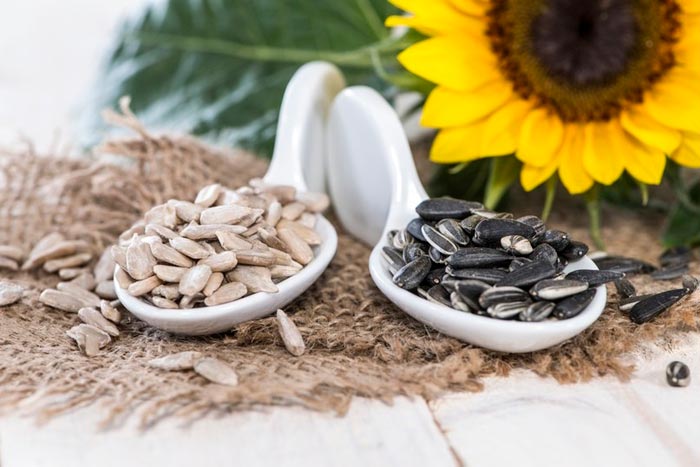

Sunflower seeds
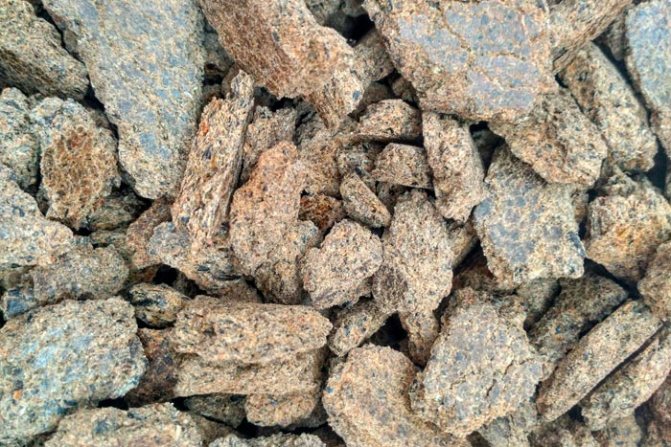

Sunflower cake
Chocolate
Rabbits should not be fed with any confectionery: sweets, pies, bread, chocolate. These foods will cause digestive upset.
Nuts
There is no scientific evidence that animals should not be fed with nuts. But feeding them is not practiced, due to economic inexpediency.
Milk
Rabbits are vegan and do not require animal food. Milk is sometimes added to the drinking water of rabbits feeding their offspring to increase milk flow. You can not give rabbits yogurt, cottage cheese, cheese.
Meat and other products
Animals are not given meat, mushrooms and fish. The stomach of animals is not able to assimilate such heavy food.
Tomato and potato tops
The tops of nightshade crops, which, in addition to tomatoes and potatoes, include eggplants, hot and bell peppers, contain toxic substances. Rabbits are very sensitive to solanine and can die from this diet.
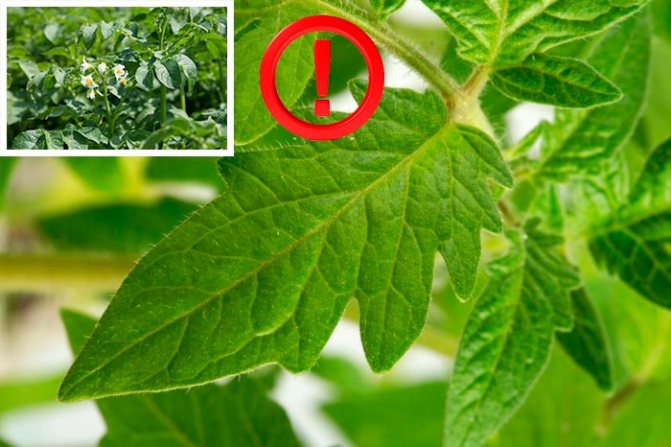

Conditionally permitted types of feed
Some foods can be given to eared pets in a limited way, offering a proven alternative.
Vegetables
Carefully fed to animals:
- cucumbers and red beets due to their laxative effect;
- turnips, radishes;
- fruits of sweet pepper.
Fruits
Juicy fruits and berries are given to pets in small quantities so as not to cause diarrhea. You can give watermelon, melon, strawberries, raspberries, currants, bananas (pulp).
Cereals
Rye is given to rabbits with care. Grain increases acidity, causes the formation of gases. The share of rye in the feed mixture should not exceed 5%.
Legumes
Peas, lentils, beans are nutritious and easily digestible foods. But for gentle digestion of animals, this grain is given carefully:
- peas are given only in crushed or presoaked form;
- boil red beans, drain the broth;
- Because of their large size and hardness, Russian beans are reluctant to eat.
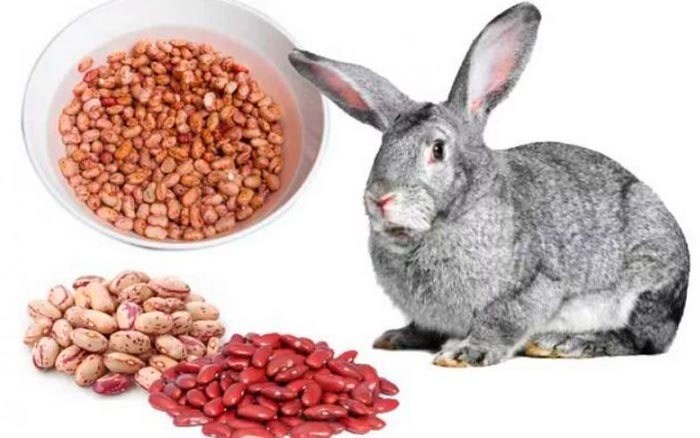

Compound feed
In the absence of specialized rabbit combination feed it is allowed to use pork feed for fattening animalsx. Mixtures for birds are not given to animals due to the high content of gravel and shell rock in the product. Cow compound feed contains a lot of salt, so it is also not suitable for feeding rabbits.
Berries
Stone fruits (cherry, sweet cherry, plum, apricot) are given to the animals with care, removing the stone. The nucleolus contains poisonous substances that are deadly to animals.
How to water rabbits
Clean fresh water should be kept in the drinker at all times. It is convenient to use vacuum drinking bowls as they do not get dirty.
On average, a rabbit drinks about 1 liter of water per day. When feeding with dry feed (hay, mixed feed), the need of animals for water increases, and when giving succulent feed, it decreases.
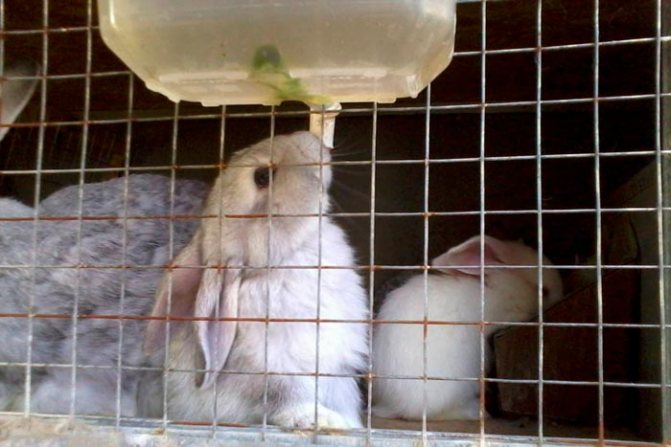

A balanced diet has a positive effect on the health of the livestock.It is important to take into account the seasonality of food, make supplies for the winter in a timely manner, so that the animals receive the necessary substances in the cold season. Farmers adjust the diet of rabbits based on their age and condition.
How to prepare food for the winter?
- In winter, animals also need vitamins and minerals. Therefore, it is best to start preparing food in advance;
- It is necessary to choose the juiciest and youngest grass;
- You can not collect green fodder near roads and railways;
- It is best to dry such food in sunny areas - verandas, roofs, high floorings;
- When storing at home, the food is sprinkled with table salt;
- In winter, mold should not be allowed;
- At least once a day, the animals are given dry grass mixed with succulent and roughage.

